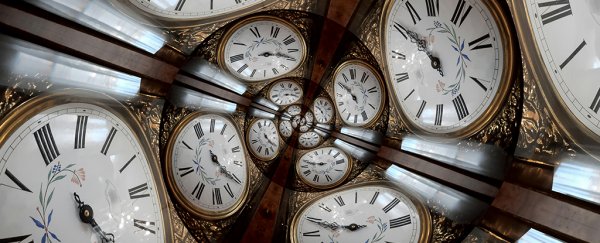Nothing keeps time like the beating heart of an atom. But even the crisp tick-tock of a vibrating nucleus is limited by uncertainties imposed by the laws of quantum mechanics.
Several years ago, researchers from MIT and the University of Belgrade in Serbia proposed that quantum entanglement could push clocks beyond this blurry boundary.
Now, we have a proof of concept in the form of an experiment. Physicists connected together a cloud of ytterbium-171 atoms with streams of photons reflected from a surrounding hall of mirrors and measured the timing of their tiny wiggles.
Their results show that entangling atoms in this way could speed up the time-measuring process of atomic nuclei clocks, making them more precise than ever. In principle, a clock based on this new approach would lose just 100 milliseconds since the dawn of time itself.
Similar to other cutting-edge clocks based on the nuclei of atoms of caesium and thorium, time in this kind of setup is divided by oscillations in a ytterbium nucleus after it absorbs a specific energy of light.
Since ytterbium's core can be made to hum at a rate 100,000 times faster than the nucleus of a caesium atom, it makes for a far more precise time-keeping mechanism.
But there comes a point when quantum physics says it's impossible to say exactly where an atom's oscillations start and stop. This Standard Quantum Limit (SQL) acts like a blur on the atomic pendulum; you might have a faster ticking clock, but what good does it do if you can't even measure it?
Without a way to overcome this obstacle, it doesn't really matter if we swap out one set of atomic nuclei for a more precise type – their quantum messiness sets a hard limit on the precision of atomic clocks.
One trick is to record the frequencies of multiple atoms humming all at once within a lattice consisting of hundreds of tiny atomic pendulums. Current atomic clock technologies use lasers engineered to be as stable as possible, providing each atom with an extremely similar frequency of light. By combining their collective blur, individual uncertainties average out.
This new method goes a step further in this averaging process. By connecting atoms together in a way that entangles the quantum probabilities of their spins, it's possible to redistribute the uncertainty in the system, increasing the precision in some parts at the expense of others.
"It's like the light serves as a communication link between atoms," says MIT physicist Chi Shu.
"The first atom that sees this light will modify the light slightly, and that light also modifies the second atom, and the third atom, and through many cycles, the atoms collectively know each other and start behaving similarly."
No matter which method is used, the longer you listen, the more precise the end result will be. In this case, the team found entanglement made the measurement process roughly three times faster compared with clocks acting at the SQL.
That might not seem all that dramatic, but a speed boost could be just the thing we need to study some of the more subtle influences the Universe has on time.
"As the Universe ages, does the speed of light change? Does the charge of the electron change?" says lead researcher Vladan Vuletic from MIT.
"That's what you can probe with more precise atomic clocks."
It could even allow us to find the point at which general relativity falls apart, pointing to new physics that connects the defined curvature of space-time with the uncertain nature of quantum fields. Or allow us to better measure the fine time-warping characteristics of dark matter.
Standing at the edge of a new age in physics and astronomy, we're really going to need time on our side.
This research was published in Nature.
